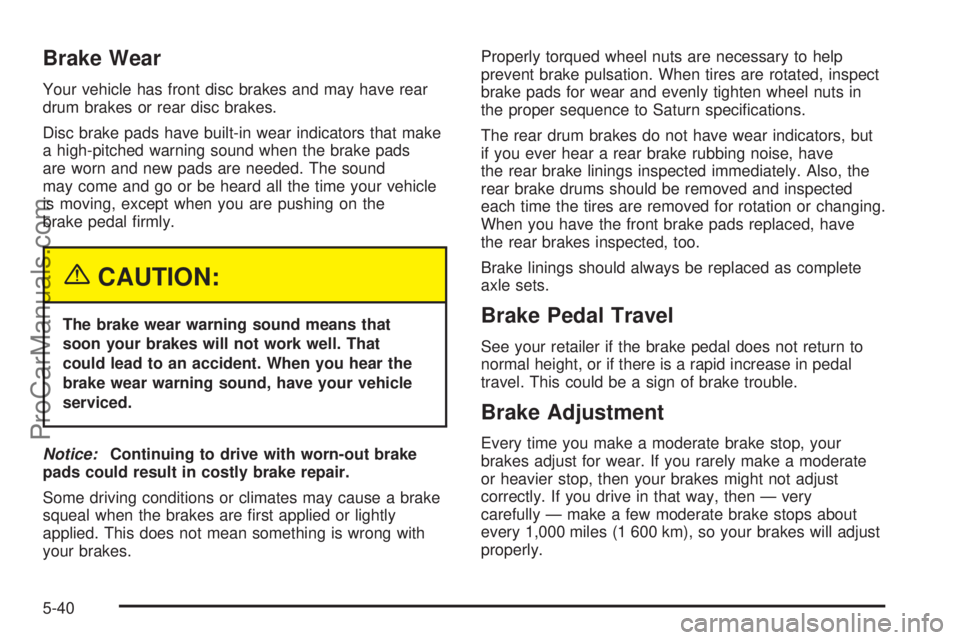height adjustment SATURN ION 2005 Owners Manual
[x] Cancel search | Manufacturer: SATURN, Model Year: 2005, Model line: ION, Model: SATURN ION 2005Pages: 366, PDF Size: 2.74 MB
Page 7 of 366

Front Seats......................................................1-2
Manual Seats................................................1-2
Driver Seat Height Adjuster..............................1-3
Manual Lumbar..............................................1-3
Reclining Seatbacks........................................1-4
Head Restraints.............................................1-5
Passenger Folding Seatback............................1-6
Rear Seats.......................................................1-9
Split Folding Rear Seat...................................1-9
Safety Belts...................................................1-10
Safety Belts: They Are for Everyone................1-10
Questions and Answers About Safety Belts......1-15
How to Wear Safety Belts Properly.................1-16
Driver Position..............................................1-16
Shoulder Belt Height Adjustment (Sedan).........1-22
Safety Belt Use During Pregnancy..................1-23
Right Front Passenger Position.......................1-23
Rear Seat Passengers..................................1-23
Rear Safety Belt Comfort Guides....................1-26
Safety Belt Pretensioners...............................1-29
Safety Belt Extender.....................................1-29
Child Restraints.............................................1-30
Older Children..............................................1-30
Infants and Young Children............................1-32
Child Restraint Systems.................................1-36Where to Put the Restraint.............................1-39
Top Strap....................................................1-39
Top Strap Anchor Location.............................1-41
Lower Anchors and Tethers for
Children (LATCH)......................................1-42
Securing a Child Restraint Designed for the
LATCH System.........................................1-43
Securing a Child Restraint in a Rear Seat
Position...................................................1-44
Securing a Child Restraint in the Right Front
Seat Position............................................1-46
Airbag System...............................................1-49
Where Are the Airbags?................................1-51
When Should an Airbag In�ate?.....................1-54
What Makes an Airbag In�ate?.......................1-55
How Does an Airbag Restrain?.......................1-56
What Will You See After an Airbag In�ates?.....1-56
Servicing Your Airbag-Equipped Vehicle...........1-58
Adding Equipment to Your Airbag-Equipped
Vehicle....................................................1-59
Restraint System Check..................................1-59
Checking the Restraint Systems......................1-59
Replacing Restraint System Parts After
a Crash...................................................1-60
Section 1 Seats and Restraint Systems
1-1
ProCarManuals.com
Page 28 of 366

To unlatch the belt, just push the button on the buckle.
The belt should go back out of the way.
Before you close the door, be sure the belt is out of the
way. If you slam the door on it, you can damage
both the belt and your vehicle.
Shoulder Belt Height Adjustment
(Sedan)
Before you begin to drive, move the shoulder belt height
adjuster to the height that is right for you. Adjust the
height so that the shoulder portion of the belt is centered
on your shoulder. The belt should be away from your
face and neck, but not falling off your shoulder.
To move it up or down,
press the square button (A)
in the center of the
height adjuster knob and
move the height adjuster to
the desired position.
After you move the height adjuster to where you want it,
try to move it up and down without touching the
square button to make sure it has locked into position.
1-22
ProCarManuals.com
Page 260 of 366

Brake Wear
Your vehicle has front disc brakes and may have rear
drum brakes or rear disc brakes.
Disc brake pads have built-in wear indicators that make
a high-pitched warning sound when the brake pads
are worn and new pads are needed. The sound
may come and go or be heard all the time your vehicle
is moving, except when you are pushing on the
brake pedal �rmly.
{CAUTION:
The brake wear warning sound means that
soon your brakes will not work well. That
could lead to an accident. When you hear the
brake wear warning sound, have your vehicle
serviced.
Notice:Continuing to drive with worn-out brake
pads could result in costly brake repair.
Some driving conditions or climates may cause a brake
squeal when the brakes are �rst applied or lightly
applied. This does not mean something is wrong with
your brakes.Properly torqued wheel nuts are necessary to help
prevent brake pulsation. When tires are rotated, inspect
brake pads for wear and evenly tighten wheel nuts in
the proper sequence to Saturn speci�cations.
The rear drum brakes do not have wear indicators, but
if you ever hear a rear brake rubbing noise, have
the rear brake linings inspected immediately. Also, the
rear brake drums should be removed and inspected
each time the tires are removed for rotation or changing.
When you have the front brake pads replaced, have
the rear brakes inspected, too.
Brake linings should always be replaced as complete
axle sets.Brake Pedal Travel
See your retailer if the brake pedal does not return to
normal height, or if there is a rapid increase in pedal
travel. This could be a sign of brake trouble.
Brake Adjustment
Every time you make a moderate brake stop, your
brakes adjust for wear. If you rarely make a moderate
or heavier stop, then your brakes might not adjust
correctly. If you drive in that way, then — very
carefully — make a few moderate brake stops about
every 1,000 miles (1 600 km), so your brakes will adjust
properly.
5-40
ProCarManuals.com